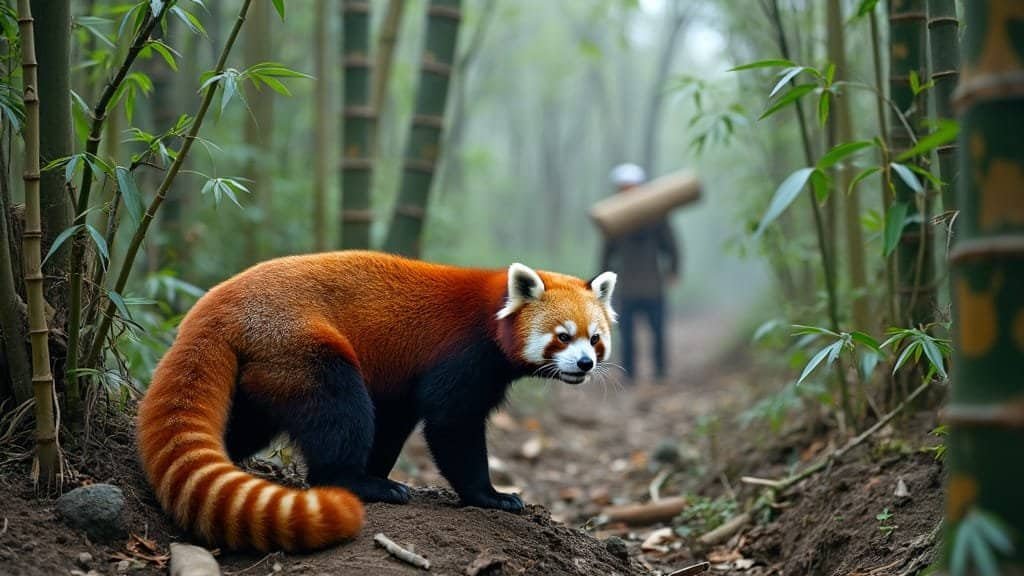Introduction
Habitat loss is one of the leading causes of red panda population decline. As forests are cleared for agriculture, logging, and infrastructure development, red pandas lose the bamboo-rich habitats they rely on for survival
Habitat fragmentation further isolates red panda populations, limiting their access to food and mates, and increasing their vulnerability to predators
This article examines how habitat loss affects red panda population trends, exploring the impacts of deforestation, habitat fragmentation, and human encroachment. We will also discuss the conservation efforts aimed at protecting red panda habitats and addressing the challenges posed by habitat loss
How Deforestation Contributes to Red Panda Population Decline
Deforestation is a major driver of red panda population decline, as it leads to the destruction of the forests they depend on for food and shelter. Red pandas are highly specialized in their habitat needs, relying on cool, high-altitude forests with a dense bamboo understory
As these forests are cleared for agriculture, logging, and human development, red pandas are left with fewer areas where they can thrive. The loss of their natural habitats causes red panda populations to shrink as they struggle to find enough food and safe nesting areas, making it difficult for them to survive and reproduce
The Effects of Logging on Red Panda Habitats
Illegal and commercial logging are significant contributors to the destruction of red panda habitats. Logging activities remove large trees that are critical for maintaining the forest structure and create clearings that disrupt the balance of the ecosystem
This not only affects the forest’s ability to support red pandas but also leads to the degradation of bamboo forests, which are their primary food source
When large trees are removed, it causes increased sunlight to reach the forest floor, which can dry out the soil and make it less suitable for bamboo growth. Additionally, the heavy machinery used in logging operations can damage bamboo plants and other vegetation, further reducing the availability of food for red pandas
As logging operations continue to expand into previously undisturbed areas, red panda populations are forced into smaller and more fragmented patches of forest, increasing their risk of starvation and predation
Research by Yonzon and Hunter (1991) found that deforestation and logging activities in Nepal significantly reduced the availability of bamboo, which led to population declines in the red pandas living in the affected areas. The study emphasized that protecting remaining forested areas is crucial for ensuring the survival of red pandas in the wild
Human Encroachment and Its Impact on Forest Cover
Human encroachment into forested areas has a direct impact on red panda habitats, as forests are cleared for agriculture, settlements, and infrastructure development
In many red panda range countries, growing human populations have led to increased demand for land and resources, pushing into previously protected or remote forest regions. This expansion results in habitat fragmentation, as large forested areas are divided into smaller patches that are less suitable for red pandas
As human settlements encroach into forested areas, the risk of conflict between red pandas and humans increases. Red pandas may be forced to venture into agricultural lands in search of food, where they are more likely to be exposed to domestic animals or hunting pressures
Additionally, the construction of roads and other infrastructure further fragments their habitats, making it harder for red pandas to move between forest patches and find the resources they need to survive
Studies by Qi et al. (2009) highlight the negative impact of human encroachment on red panda populations in China, showing that as human activities expand into forested areas, red pandas experience increased habitat loss and population fragmentation, leading to a decline in their overall numbers
Loss of Bamboo Forests and Red Panda Food Shortages
Bamboo is the primary food source for red pandas, and the loss of bamboo forests due to deforestation is a significant threat to their survival. Red pandas consume large amounts of bamboo each day, relying on the dense bamboo undergrowth found in temperate forests
When these forests are cleared or degraded, the bamboo that red pandas depend on becomes scarce, leading to food shortages that can have devastating effects on red panda populations
Bamboo forests are highly sensitive to environmental changes, and deforestation disrupts the delicate balance needed for bamboo to thrive. As forest cover is lost, the microclimate that supports bamboo growth is altered, leading to reduced bamboo availability. Without enough bamboo to eat, red pandas may face malnutrition, lower reproductive success, and increased mortality rates
Research by Wei et al. (1999) shows that the loss of bamboo forests in China due to logging and deforestation has led to significant declines in red panda populations
The study found that red pandas in areas with reduced bamboo availability had lower survival rates and were less likely to reproduce, highlighting the critical importance of preserving bamboo forests for the survival of the species
Habitat Fragmentation and Its Impact on Red Panda Survival
Habitat fragmentation, caused by deforestation and human development, is one of the most significant threats to red panda survival. As large, continuous forest areas are broken into smaller, isolated patches, red pandas lose access to essential resources, such as food and mates
Fragmented habitats also increase their vulnerability to predation and reduce genetic diversity, weakening the population’s overall resilience. The effects of habitat fragmentation extend beyond individual red pandas, impacting the long-term health and sustainability of entire populations
How Fragmented Habitats Limit Red Panda Movement
Red pandas rely on continuous forest cover for their survival, as it provides the bamboo they feed on, shelter from predators, and access to mates
When forests are fragmented by deforestation, roads, and other human activities, red pandas are forced into smaller, isolated patches of habitat. These fragmented forests limit red pandas’ ability to move freely, making it harder for them to find sufficient food and safe nesting areas
In a fragmented landscape, red pandas may have to travel across open or dangerous areas to reach other forest patches, increasing their exposure to predators and human threats. Additionally, fragmented habitats disrupt red pandas’ natural behaviors, such as establishing home ranges and foraging, which can lead to malnutrition, lower reproductive success, and increased mortality
Research by Yonzon and Hunter (1991) shows that red pandas in fragmented habitats face higher risks of starvation and predation due to the difficulty of accessing food and shelter. The study highlights the need to preserve continuous forest cover to maintain healthy red panda populations
Genetic Isolation and Its Effect on Population Health
Habitat fragmentation isolates red panda populations, reducing the opportunity for individuals to migrate and breed with other groups. This isolation leads to genetic bottlenecks, where a small, isolated population is more likely to experience inbreeding, which reduces genetic diversity
Low genetic diversity makes red pandas more vulnerable to diseases, environmental changes, and other threats, weakening their ability to adapt and survive in a changing environment
Over time, genetic isolation can have serious consequences for red panda populations. Inbreeding can result in genetic defects and decreased reproductive success, leading to smaller and less resilient populations
As habitat fragmentation continues to increase, the risk of population declines due to genetic isolation becomes more severe
Research by Wei et al. (1999) indicates that fragmented red panda populations in China show signs of reduced genetic diversity, which has long-term consequences for the health and viability of these populations
The study suggests that maintaining habitat connectivity is crucial for promoting genetic diversity and ensuring the survival of red panda populations
Increased Risk of Predation Due to Habitat Fragmentation
Another critical impact of habitat fragmentation is the increased risk of predation for red pandas. In continuous, dense forests, red pandas are able to find shelter in the canopy and undergrowth, where they can hide from predators such as snow leopards, wild dogs, and birds of prey
However, when forests are fragmented, red pandas are more exposed to predators as they travel between forest patches or move through degraded areas with less cover
Fragmented habitats also lead to changes in predator-prey dynamics. As red pandas are forced into smaller, more confined areas, they become easier targets for predators, and their chances of surviving predatory attacks decrease
The loss of dense forest cover not only makes it harder for red pandas to find food but also reduces their ability to evade predators
Research by Qi et al. (2009) highlights the increased predation risks faced by red pandas in fragmented habitats. The study found that red pandas living in fragmented forest patches had higher mortality rates due to predation compared to those in larger, more intact forests
How Habitat Loss Affects Red Panda Reproductive Success
Habitat loss and fragmentation have profound effects on red panda reproductive success. As their habitats shrink and become more isolated, red pandas face reduced access to mates, lower cub survival rates, and decreased population growth
The challenges associated with finding suitable mates in fragmented environments, combined with the pressures of habitat degradation, lead to declining red panda populations
Understanding the impact of habitat loss on red panda reproduction is crucial for developing effective conservation strategies
Reduced Mating Opportunities in Fragmented Habitats
Red pandas rely on large, continuous territories to find mates, establish home ranges, and reproduce. In fragmented habitats, their access to potential mates is severely restricted, as forest patches become isolated and disconnected
Red pandas may have to travel long distances to find a mate, crossing dangerous or unsuitable terrain, which increases their vulnerability to predators and reduces the likelihood of successful mating
The isolation of red panda populations also results in smaller group sizes, which decreases the chances of individuals encountering mates within their own habitat patches. This lack of connectivity between forest areas leads to lower reproductive rates, as red pandas are unable to find suitable partners during the breeding season
Research by Pradhan et al. (2001) shows that habitat fragmentation is a significant factor in reducing mating opportunities for red pandas. The study found that red pandas in fragmented habitats had lower reproductive success due to limited access to mates and smaller population sizes
Lower Cub Survival Rates Due to Habitat Degradation
Habitat degradation, caused by deforestation, logging, and human encroachment, negatively impacts the survival rates of red panda cubs. Red panda cubs are born in tree hollows or dense thickets, where they are vulnerable to predation and environmental pressures
When forest cover is lost or degraded, these safe nesting sites become scarce, leaving red panda mothers with fewer options for protecting their young
In degraded habitats, red panda cubs are more exposed to predators, harsh weather conditions, and food shortages. The loss of bamboo forests, in particular, reduces the availability of food for red panda mothers, which in turn affects their ability to nourish their cubs
Malnutrition and increased vulnerability to predation lead to higher mortality rates among red panda cubs, further contributing to population decline
Research by Wei et al. (1999) highlights the link between habitat degradation and cub survival rates, showing that red panda populations in degraded habitats experience higher cub mortality due to the lack of suitable nesting sites and reduced food availability
Habitat Degradation and its Long-Term Impact on Population Growth
The long-term effects of habitat degradation extend beyond individual red pandas to the entire population. As habitats are lost or degraded, red panda populations experience lower reproductive success and higher mortality rates, leading to a decline in population growth
Over time, this can result in smaller, more isolated populations that are less resilient to environmental changes and more vulnerable to extinction
In addition to reducing reproductive success, habitat loss can disrupt the social structure of red panda populations. Red pandas are generally solitary animals, but they rely on overlapping territories to find mates and maintain genetic diversity. When habitat fragmentation separates these territories, it limits their ability to maintain healthy population dynamics, further contributing to population decline
Studies by Qi et al. (2009) demonstrate the long-term impact of habitat degradation on red panda population growth, showing that areas with significant habitat loss have experienced steady declines in red panda numbers
The research emphasizes the importance of protecting remaining habitats and restoring degraded areas to ensure the long-term survival of red panda populations
Conservation Efforts to Address Habitat Loss in Red Panda Populations
Conservation efforts aimed at mitigating habitat loss are critical to the survival of red pandas. These efforts focus on protecting remaining habitats, restoring degraded areas, and promoting sustainable practices that reduce human impact on forests
By creating protected areas, supporting reforestation, and engaging local communities in conservation strategies, organizations are working to reverse the decline in red panda populations caused by habitat loss and fragmentation
Protected Areas and Their Role in Red Panda Conservation
One of the most effective ways to protect red panda habitats is through the establishment of protected areas. National parks, wildlife sanctuaries, and conservation reserves provide safe spaces where red pandas can live without the threat of deforestation, illegal logging, or habitat encroachment
In these areas, forest ecosystems remain intact, allowing red pandas to access the bamboo they need and maintain their natural behaviors
Protected areas in countries like Nepal, Bhutan, India, and China play a vital role in preserving the habitats of red pandas. For example, Nepal’s Langtang National Park and Bhutan’s Jigme Dorji National Park are key protected areas where red panda populations are thriving due to strict conservation policies and enforcement
These parks not only safeguard red panda habitats but also contribute to broader biodiversity conservation
Research by Yonzon and Hunter (1991) highlights the importance of protected areas for red panda conservation, showing that red panda populations in these areas have more stable numbers compared to those in unprotected, fragmented habitats
The study underscores the need for continued investment in expanding and managing protected areas to ensure the long-term survival of red pandas
Reforestation and Bamboo Replanting Initiatives
Reforestation is a critical component of red panda conservation, particularly in regions where deforestation has significantly reduced forest cover
Conservation organizations and local communities work together to restore degraded habitats by planting native trees and bamboo, which are essential for red panda survival
Reforestation efforts help to rebuild the ecosystems that red pandas rely on, providing them with food, shelter, and corridors for movement between fragmented patches of forest
Bamboo replanting is especially important, as bamboo is the primary food source for red pandas. In areas where bamboo has been depleted due to logging or land use changes, replanting efforts focus on restoring bamboo forests to ensure a steady food supply
These projects often involve local villagers who are trained to plant and care for bamboo, creating sustainable livelihoods while supporting red panda conservation
Research by Qi et al. (2009) shows that reforestation and bamboo replanting efforts have had a positive impact on red panda populations in China. The study found that areas where bamboo forests were restored experienced increases in red panda sightings and a stabilization of local populations, demonstrating the effectiveness of habitat restoration in reversing population declines
Community-Based Conservation Strategies to Combat Habitat Loss
Engaging local communities in conservation efforts is key to the long-term success of red panda habitat protection. Community-based conservation programs empower local residents to take an active role in managing and protecting their forests
These programs often provide economic incentives, such as eco-tourism, sustainable farming, or reforestation jobs, which reduce the reliance on activities that harm red panda habitats, such as illegal logging or unsustainable agriculture
For example, in Nepal, the Red Panda Network has implemented a community-based conservation program that trains villagers to monitor red panda populations and protect their habitats
These “forest guardians” are responsible for patrolling forest areas, reporting illegal activities, and participating in habitat restoration projects. The program has not only helped protect red panda habitats but has also provided local communities with sustainable income opportunities
Studies by Wei et al. (1999) highlight the success of community-based conservation initiatives in promoting habitat protection and reducing deforestation. The research shows that when local communities are involved in conservation, habitat loss decreases, leading to better outcomes for red pandas and other wildlife
Conclusion
Habitat loss, primarily caused by deforestation, fragmentation, and human encroachment, is a significant threat to red panda populations. As forests are cleared and fragmented, red pandas face reduced access to food, limited mating opportunities, and increased vulnerability to predators
Habitat degradation also leads to lower cub survival rates and decreased population growth, further endangering the species. The isolation of red panda populations caused by habitat fragmentation also threatens genetic diversity, weakening the population’s resilience to environmental changes
Conservation efforts aimed at addressing habitat loss are crucial for reversing these trends. Protected areas, such as national parks and wildlife reserves, offer safe havens for red pandas, allowing them to live and reproduce without the constant threat of habitat destruction
Reforestation and bamboo replanting initiatives help restore degraded habitats, ensuring that red pandas have access to their primary food source
Additionally, community-based conservation strategies empower local residents to take part in protecting forests while creating sustainable economic opportunities that reduce reliance on activities harmful to red panda habitats
For red pandas to thrive, it is essential that these conservation efforts continue to expand, with a focus on preserving habitat connectivity and engaging local communities
Protecting red panda habitats from further degradation and ensuring the regeneration of bamboo forests are critical steps in securing the future of this unique and vulnerable species











